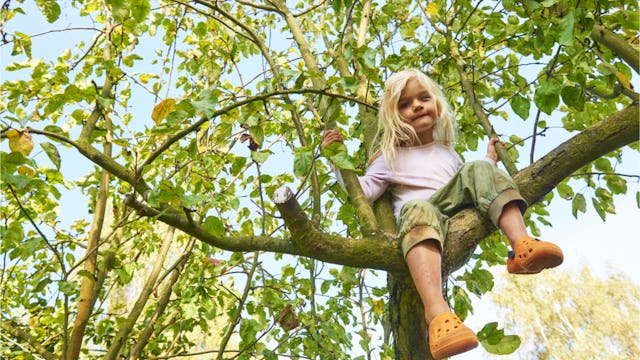In Defense Of Climbing Trees And Other Risky Play

A few years ago, I looked out the back window to see my then-5-year-old near the top of a 20-foot tree in the backyard. It took me a moment to figure out what I was seeing since his tiny body in the big tree looked completely out of place and yet totally at ease at the same time.
I shouted to him, “Be smart up there!” and then snapped a picture, pushing fears of an inevitable trip to the ER out of my mind. He was, thankfully, fine, and he still continues to climb to the top of the tree. My husband and I not only don’t stop him, but we encourage it too.
Image via Christine Organ
The mere thought of a 5-year-old climbing to the top of a tree, unsupervised, might send chills down most parents’ spines. Some parents might say we’re careless at best, or negligent at worst. To which I would respectfully and emphatically disagree.
Kids are safer now than ever before, yet for some reason, some parents just can’t seem to chill out. Some parents prefer the “Cover Them in Bubble Wrap” style of parenting to the “Let Them Bleed” style.
But what do we get when we helicopter the hell out of our kids?
We get anxious kids who don’t know how to manage fear, anger, or failure. We project our fears onto our kids. And whether we realize it or not, we are telling our kids that we don’t trust them, that they are incapable, that they aren’t up to the challenge.
When we encourage risky play and help them overcome their fears, however, we show them how to safely manage dangers and responsibly take risks. We tell them — not just with words, but with actions — that we trust them and they are capable.
This isn’t just my parental opinion. Science says so, too. In fact, data is so strong that many experts support the emotion regulation theory of play, which is really just a fancy way of saying kids learn how to regulate their emotions through play.
With rough-and-tumble play, kids learn how to overcome anger. When engaged in risky play, kids get manageable quantities of fear, so they can practice keeping their wits about them and behaving adaptively while experiencing fear. In other words, researchers and psychologists say that kids “learn that they can manage their fear, overcome it, and come out alive.” That’s a pretty vital skill.
By learning how to manage fear and anger, kids learn how to manage real-life dangers without giving in to their negative emotions. But without risky play, there can be increased cases of neuroticism or psychopathology. In fact, experts say that over the past 60 years, they have noticed a continuous, gradual, but dramatic decline in the opportunities to play unsupervised and freely, with a significant reduction in risky play in particular. Over the same period of time, there has also been a gradual increase in all kinds of childhood mental health disorders, especially emotional disorders. Coincidence? Experts don’t think so.
The biggest danger for our kids isn’t the tall trees they climb or the rough way they play with each other. It’s us. It’s parents. We are the biggest risk to our kids.
“I think there’s such a big, big emphasis on raising the perfect child and making sure that our child has access to music lessons and sports lessons, skating, swimming — all of those critical, tangible skills that parents are on some level expected to cultivate in their children that we lose out on giving our kids the chance to develop some of those soft skills: the opportunity to problem-solve and teamwork and develop genuine relationships with other kids just throughout the process of peer play,” says Matt Leung, a team lead in active play for Calgary-based Vivo.
Ironically, it’s adult-driven activities, like organized sports, that usually result in the most injuries. According to the U.S. Centers for Disease Control and Prevention, more than 3.5 million children per year under the age of 14 receive medical treatment for sports injuries. Experts say this is because “the adult encouragement and competitive nature of the sports lead children to take risks — both of hurting themselves and of hurting others — that they would not choose to take in free play.”
Instead of telling our kids what to do and how to do it, and having them do the same activities repeatedly, Leung suggests piquing their curiosity. Asking questions like “Have you tried this?” or “Could you get to the top in a different way?” are good ways to encourage independence, free play, and thoughtful risks.
So step aside, parents. Let your kids walk to school with their peers. Close your eyes when they climb to the top of the tree. Bite your tongue when you want to shout “be careful” or “not so high.” Encourage your kids to go higher, farther, and do all those things you’re afraid they can’t do — even if it does mean you’ll be holding your breath and trying not to freak out.
This article was originally published on